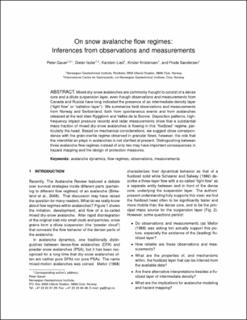| dc.contributor.author | Gauer, Peter | |
| dc.contributor.author | Issler, Dieter | |
| dc.contributor.author | Lied, Karstein | |
| dc.contributor.author | Kristensen, Krister | |
| dc.contributor.author | Sandersen, Frode | |
| dc.date.accessioned | 2023-09-18T06:00:10Z | |
| dc.date.available | 2023-09-18T06:00:10Z | |
| dc.date.issued | 2008 | |
| dc.identifier.uri | https://hdl.handle.net/11250/3089940 | |
| dc.description.abstract | Mixed dry-snow avalanches are commonly thought to consist of a dense core and a dilute suspension layer, even though observations and measurements from Canada and Russia have long indicated the presence of an intermediate-density layer (“light flow” or “saltation layer”). We summarize field observations and measurements from Norway and Switzerland, both from spontaneous events and from avalanches released at the test sites Ryggfonn and Vallee de la Sionne. Deposition patterns, high- ´ frequency impact pressure records and radar measurements show that a substantial mass fraction of mixed dry-snow avalanches is flowing in this “fluidized” regime, par ticularly the head. Based on mechanical considerations, we suggest close correspon dence with the grain-inertia regime observed in granular flows; however, the role that the interstitial air plays in avalanches is not clarified at present. Distinguishing between three avalanche flow regimes instead of only two may have important consequences in hazard mapping and the design of protection measures. | en_US |
| dc.language.iso | eng | en_US |
| dc.publisher | Montana State University Library | en_US |
| dc.relation.ispartofseries | The International Snow Science Workshop (ISSW) Proceedings; | |
| dc.subject | Snow Avalanche | en_US |
| dc.subject | Dynamic Load | en_US |
| dc.subject | Flow | en_US |
| dc.subject | Avalanche-RnD | en_US |
| dc.subject | Snøskred-FoU | en_US |
| dc.title | On snow avalanche flow regimes: Inferences from observations and measurements. | en_US |
| dc.type | Chapter | en_US |
| dc.source.pagenumber | 7 | en_US |
